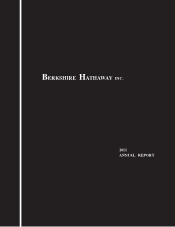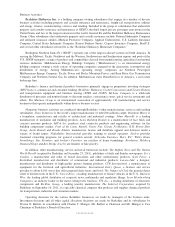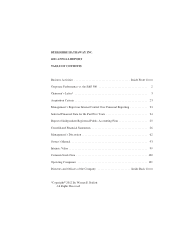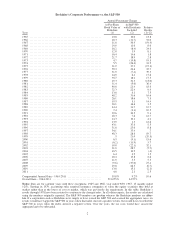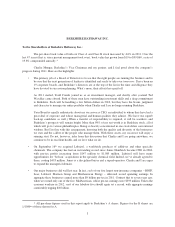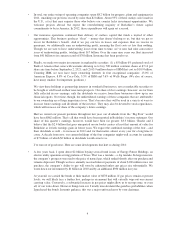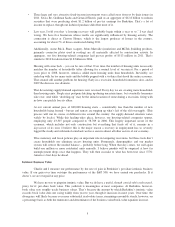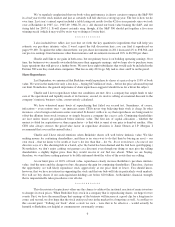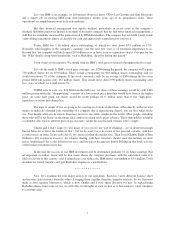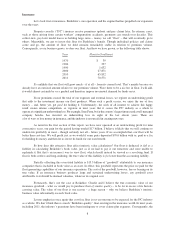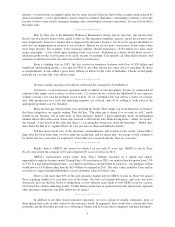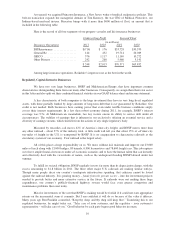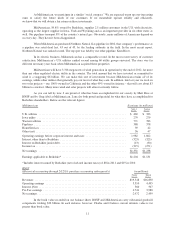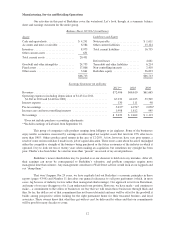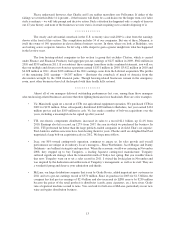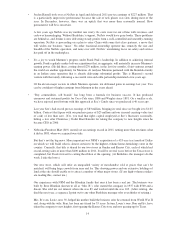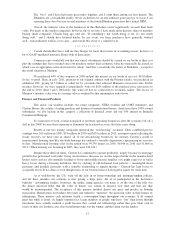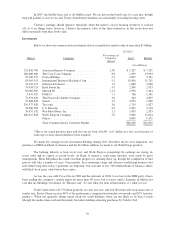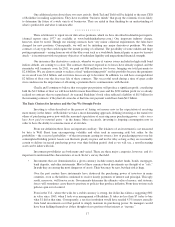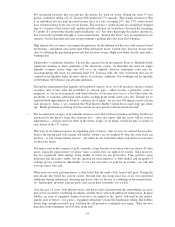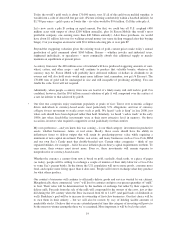Berkshire Hathaway 2011 Annual Report Download - page 11
Download and view the complete annual report
Please find page 11 of the 2011 Berkshire Hathaway annual report below. You can navigate through the pages in the report by either clicking on the pages listed below, or by using the keyword search tool below to find specific information within the annual report.industry’s overall return on tangible equity has for many decades fallen far short of the average return realized by
American industry, a sorry performance almost certain to continue. Berkshire’s outstanding economics exist only
because we have some terrific managers running some extraordinary insurance operations. Let me tell you about
the major units.
************
First by float size is the Berkshire Hathaway Reinsurance Group, run by Ajit Jain. Ajit insures risks
that no one else has the desire or the capital to take on. His operation combines capacity, speed, decisiveness and,
most importantly, brains in a manner that is unique in the insurance business. Yet he never exposes Berkshire to
risks that are inappropriate in relation to our resources. Indeed, we are far more conservative in that respect than
most large insurers. For example, if the insurance industry should experience a $250 billion loss from some
mega-catastrophe – a loss about triple anything it has ever faced – Berkshire as a whole would likely record a
moderate profit for the year because of its many streams of earnings. Concurrently, all other major insurers and
reinsurers would be far in the red, and some would face insolvency.
From a standing start in 1985, Ajit has created an insurance business with float of $34 billion and
significant underwriting profits, a feat that no CEO of any other insurer has come close to matching. By these
accomplishments, he has added a great many billions of dollars to the value of Berkshire. Charlie would gladly
trade me for a second Ajit. Alas, there is none.
************
We have another insurance powerhouse in General Re, managed by Tad Montross.
At bottom, a sound insurance operation needs to adhere to four disciplines. It must (1) understand all
exposures that might cause a policy to incur losses; (2) conservatively evaluate the likelihood of any exposure
actually causing a loss and the probable cost if it does; (3) set a premium that will deliver a profit, on average,
after both prospective loss costs and operating expenses are covered; and (4) be willing to walk away if the
appropriate premium can’t be obtained.
Many insurers pass the first three tests and flunk the fourth. They simply can’t turn their back on business
that their competitors are eagerly writing. That old line, “The other guy is doing it so we must as well,” spells
trouble in any business, but in none more so than insurance. Indeed, a good underwriter needs an independent
mindset akin to that of the senior citizen who received a call from his wife while driving home. “Albert, be careful,”
she warned, “I just heard on the radio that there’s a car going the wrong way down the Interstate.” “Mabel, they
don’t know the half of it,” replied Albert, “It’s not just one car, there are hundreds of them.”
Tad has observed all four of the insurance commandments, and it shows in his results. General Re’s
huge float has been better than cost-free under his leadership, and we expect that, on average, it will continue to
be. In the first few years after we acquired it, General Re was a major headache. Now it’s a treasure.
************
Finally, there is GEICO, the insurer on which I cut my teeth 61 years ago. GEICO is run by Tony
Nicely, who joined the company at 18 and completed 50 years of service in 2011.
GEICO’s much-envied record comes from Tony’s brilliant execution of a superb and almost-
impossible-to-replicate business model. During Tony’s 18-year tenure as CEO, our market share has grown from 2.0%
to 9.3%. If it had instead remained static – as it had for more than a decade before he took over – our premium volume
would now be $3.3 billion rather than the $15.4 billion we attained in 2011. The extra value created by Tony and his
associates is a major element in Berkshire’s excess of intrinsic value over book value.
There is still more than 90% of the auto-insurance market left for GEICO to rake in. Don’t bet against
Tony acquiring chunks of it year after year in the future. Our low costs permit low prices, and every day more
Americans discover that the Gecko is doing them a favor when he urges them to visit GEICO.com for a quote.
(Our lizard has another endearing quality: Unlike human spokesmen or spokeswomen who expensively represent
other insurance companies, our little fellow has no agent.)
************
In addition to our three major insurance operations, we own a group of smaller companies, most of
them plying their trade in odd corners of the insurance world. In aggregate, their results have consistently been
profitable and the float they provide us is substantial. Charlie and I treasure these companies and their managers.
9

